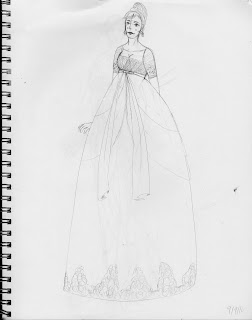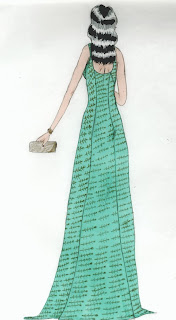It’s hard to believe that this time last year I was putting
the finishing touches on my undergraduate thesis. This paper discussed the
intersection of civic pride and literary aspirations in the form of SimonettaVespucci, a woman who lived in 15th century Florence
and might have been the model for many of Botticelli’s beauties. It might be
even harder to believe that I was instantly reminded of Simonetta when I went
to Deco Japan: Shaping Art and Culture, 1920-1945 at the Japan Society in New York this past Thursday. Fair warning, as an
exhibit it’s a little sloppy and stuffy—some items were mislabeled, some wall
text discussed pieces that were put in other rooms entirely, and there was not
a wealth of background detail for the casual observer. But the objects on
display were extraordinary, both in their beauty and in their creativity.
What interested me
the most in this exhibit was the continued and repeated emphasis on displaying
the ideal woman while men were not represented at all. The painters in the first
gallery practiced a style called Nihonga,
in which the painter used traditional media to depict a modern subject. In the
case of this exhibit, we saw plenty of stylish women, perhaps a quotation of
the many woodblock print series of great beauties. These paintings were like
breaths of fresh air, revelatory in their newness and astonishing in their
technique, images painted on a panel or on silk and attached to traditional silk
scrolls. The viewer saw women at play on the beach, at the aquarium, and at the
ski lodge—all activities, the curators mention, that the government endorsed,
since they symbolically promoted Japan’s dominance over land and sea. The most
striking painting, I felt, was Miki Suizan’s Junpu, which shows two fashionable ladies sailing in a light
breeze.
Miki Suizan, Junpu, The Flapper Girl
This painting, one
of the first objects on view, got me thinking about Simonetta. More directly,
my first reaction to this painting (and to the overall Nihonga style) was that it was better than any contemporary fashion
illustration. The clothes are perfectly observed but still stylized. Anyone
wanting to construct a pattern for an early 1930s day dress needs to look no
further than a Japanese Art Deco painting. The red dress struck me as being
suitably Botticelliean, which reminded me of the spectacular Youth and Beauty exhibit at the Brooklyn Museum this past fall. That exhibit presented
American decorative arts from the 1920s (it seems that the 1920s and 1930s are
just long enough ago to be appreciating a vogue in the museum world). That
exhibit made the case that many American artists were inspired by the Italian
Renaissance and its championing of the classical form. Were the artists who
practiced Nihonga indirectly inspired
by this same obsession with Renaissance aesthetics? Why else would they show
women involved in sports and dancing?
One answer to this
question would be the more ominous side of Japanese Art Deco: many of the items
in this exhibit were either sponsored by the fascist government, or stuck very
close to their program. Futagi Seiho’s incredible bird of paradise box is an
advertisement for the emperor’s rejuvenated power and a sign of how Japan’s colonial ambitions had already reached to
the South Pacific. One wonders what radical Japanese art at the time was like,
and if an exhibit about that would have centered so much around Westernized
depictions of traditional Japanese subjects.
But to bring this
all back to Simonetta, we must look at the moga,
the modern girl or flapper who was at the center of this exhibit. Kobayakawa Kiyoshi’s Kaidan (Staircase) shows a wealthy Japanese
woman enjoying the empire’s largesse: she is young, beautiful, leaving her home
to go to a party or perhaps a show, and though she wears a traditional kimono
has access to the latest Western accessories, imports no doubt directly related
to the rise of Japan’s industrial power in the
early 20th century. She is the epitome of the modern,
government-approved wife.

Kobayakawa Kiyoshi, Kaidan, The Design Observer Group
And then there are the transgressors: the professional,
aloof dancers featured in Enomoto Chikatoshi’s Florida series
(so named for the popular Tokyo
nightclub where the girls performed); or the muscular, voluptuous nudes of
Ishikawa Toraji. One painting in this section showed a woman reclining in bed,
covered only in a veil of imported black French lace, a second woman (a
servant?) sitting next to her, echoing Olympia or The Venus of Urbino.
Enomoto Chikatoshi, Florida, The Design Observer Group
Ishikawa Toraji, Odori, The Balustrade
Why is it that in periods of perceived renewal, whether it
be Simonetta’s Florence or the moga’s Tokyo,
do women become a site for nationalistic ambitions? Is it the hope that they
will bear model children to serve the new state? Or the misogynistic fear that
their charms will distract the model man from his “destiny” of greatness? In my
thesis, I discussed how in literature and in art Simonetta was either wearing
the guise of a fertility goddess or, after she died in real life, was depicted
as a true goddess, watching over and inspiring artists loyal to the ruling
Medici family. She became both a political and erotic object, but never a full
person.* Despite all the daring behavior the moga exhibited, they were used for the exact same purpose in the
art of Art Deco Japan.
*This is, of course, a very 21st century
complaint. In some poetry written about Simonetta, a glimmer of what might have
been her real personality shines through, but Florentine wives ultimately had
fewer rights than their own children.





















